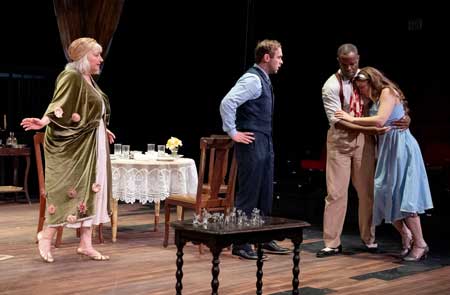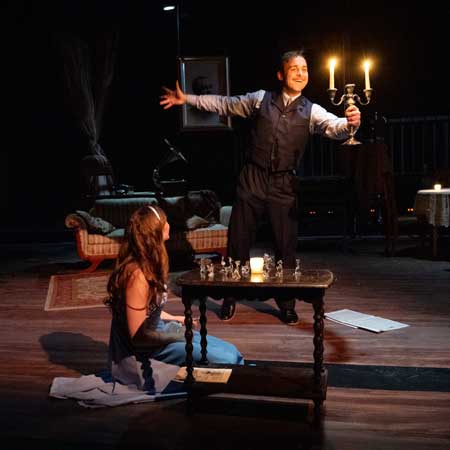Play (1944)
by Tennessee Williams
Directed by Doug Lockwood
Gloucester Stage Company
Gloucester, MA
June 5-28, 2025
Scenic Design: Jenna McFarland Lord; Costume Design: Nia Safarr Banks; Lighting Design: Amanda Fallon; Sound Design: Aubrey Dube
With Adrianne Krstansky (Amanda Wingfield), De’Lon Grant (Tom Wingfield), Lisa Giangrande (Laura Wingfield), Patrick O’Konis (Jim O’Connor)

Patrick O’Konis as Jim
De’Lon Grant as Tom
Liza Giangrande as Laura
in “The Glass Menagerie”
Photo: Shawn G. Henry
Courtesy of Gloucester Stage Company
Tom Wingfield (De’Lon Grant) lives at home with his mother, Amanda (Adrianne Krstansky) and his sister, Laura (Liza Giangrande), but exhibits considerable frustration in his rudimentary work and in the interactions he has with his mother. Amanda is urgent about having Tom bring home his work colleague Jim O’Connor (Patrick O’Konis) as a potential gentleman suitor to the unbearably shy Laura. Laura has known Tom in high school and was sweet on him, but she is terribly self-conscious about her impaired leg and associated limp. Tom invites Jim to come to the house for dinner without really owning up to the idea of it being to meet Laura, and Jim does so. Amanda, dolled up in her finest, does her best to charm Jim before she and Tom leave Jim and Laura to connect. Laura has been extremely hesitant to even come out to meet Jim, but she finally does, and especially when Laura and Tom leave them alone, they have a touching and significant encounter.
Often the character of Amanda becomes the focus of this play which, in a more conventional interpretation, largely revolves around her self-absorption and the influence of her narcissism upon her children. Consequently, the character is frequently played to full-tilt obnoxiousness, which serves to clearly set forth the stultifying psychological and emotional consequences for Laura and Tom. Even with this sort of hard-line portrayal of Amanda, one senses Tom’s resilience and his determination to break out of the prison ruled by his mother. But Laura is a different story, and, especially with that kind of univocal interpretation of Amanda’s tyranny, one observes that Laura’s frailty is likely to subject her to long-term imprisonment under her mother’s psychological thumb.
This more nuanced production intelligently makes the choice to somewhat soften some of Amanda’s harshness and to feature Laura’s vulnerability as more central on its own terms. Under this rubric, we certainly see Amanda as a powerful and generally negative influence on Laura, but not horribly so. And though Krstansky’s Amanda is certainly a self-involved nuisance, her affection for her daughter, and Laura’s affection for her, is palpable. Amanda certainly hovers annoyingly, but with something less than a tyrannical demeanor; so her urging that Tom bring Jim home to meet Laura is more of a nagging nuisance than an insolent insistence. Krstansky does a highly capable job of conveying this neurotic, but not utterly despotic, version of Amanda, offering a sense of her pathetic vulnerability rather than cruelty as the most evident trait of her self-absorption.
Given this more muted portrayal of Amanda, the interaction between Laura and Jim in this production, played with incredible eloquence and beauty by Liza Giangrande and Patrick O’Konis, takes center stage and forms the heart of this domestic tragedy. When Amanda disappears, Laura begins to blossom, and Giangrande does such a masterful job of showing how this happens that it is almost like watching a child learn to walk. She moves out of her shell in measured stages, gradually learning to radiate to Jim the deep feeling that she harbors within. It’s beautiful and heartbreaking to watch.

Patrick O’Konis as Jim
in “The Glass Menagerie”
Photo: Shawn G. Henry
Courtesy of Gloucester Stage Company
The long love scene between Jim and Laura is exquisitely done, and it is to the credit of both O’Konis and Giangrande – and clearly under Doug Lockwood’s expert direction – that it has the kind of developmental eloquence that it does. O’Konis plays Jim with an expressive and extroverted intensity that makes him seem, off the bat, like a boorish blusterer; but O’Konis carries off his character with such mastery that this brashness becomes a sweet invitation to Laura’s subtly emerging self-expressiveness. When, in the wake of the scene’s dramatic climax, Laura gives Jim a piece of her glass menagerie as a keepsake, it is an offering from a wounded but great and noble heart to an outwardly brash and extroverted, but nobly deserving recipient.
In other less nuanced productions, this relationship between Laura and Jim can be played with an entirely different tone, exhibiting a mismatch rather than a connection. That is not at all the case here, and Lockwood, Giangrande and O’Konis offer a truly great moment in which these starkly different characters hover, orbit one another, and engage with enormous sensitivity.
As Tom, De’Lon Grant offers the dual role of narrator and family member and does so with noteworthy subtlety. The drama is characterized as a memory play of Tom’s, and Grant does an excellent job of hovering between the demands of both recollecting and acting within the memories. When, in frustration, Tom explodes in response to his mother’s insistent manipulations, Grant’s portrayal is visceral and evocative, but couches it as well within the context of recollection. It’s quite a trick and Grant does a superb job.
Indeed, it is in the subtleties of these characters that the greatest power of this drama comes forth, and this wonderful production of Williams’ first entry into the greatest hits of twentieth century drama offers a potent realization of its promise.
– BADMan (aka Charles Munitz)
Leave a Reply